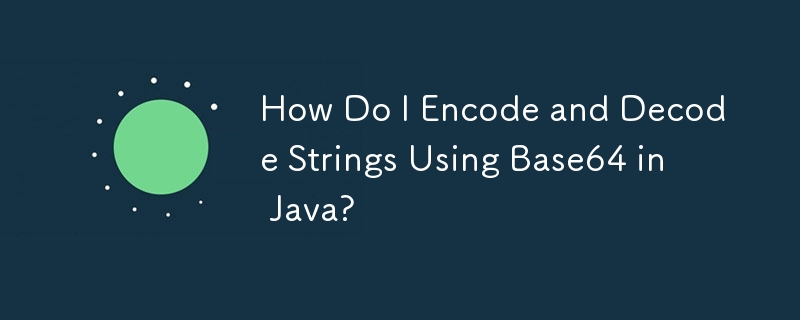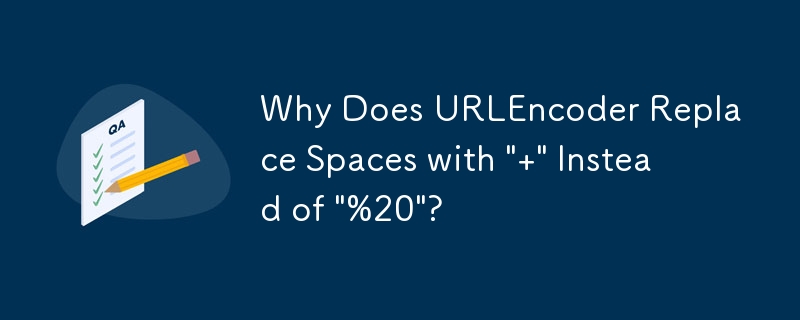Found a total of 10000 related content
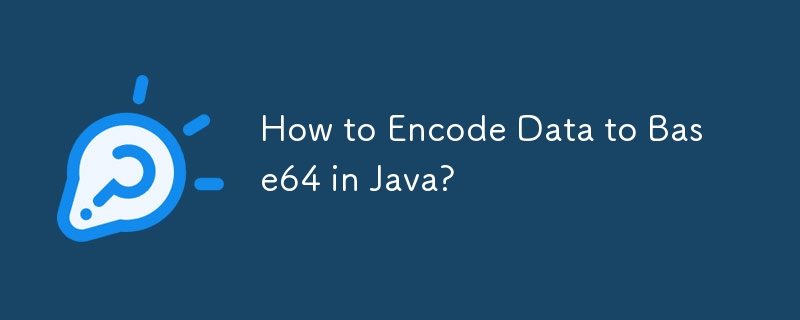
How to Encode Data to Base64 in Java?
Article Introduction:Encoding Data as Base64 in JavaEncoding Using Apache CommonsIn Java 7, the sun.misc.BASE64Encoder class previously used for Base64 encoding is now...
2024-12-22
comment 0
437

Java Chinese garbled solution Several skills for character encoding conversion
Article Introduction:To solve the problem of Chinese garbled in Java, you can use the following steps: 1. Set the correct character encoding, such as UTF-8 or GBK, to ensure that the file, database and network communication use the same encoding. 2. Use Java's character encoding conversion class to perform necessary encoding conversion. 3. Verify whether the encoding is correct through debugging tools and logs to ensure that the Chinese display is normal in different environments.
2025-05-16
comment 0
571


How to read a .properties file in Java?
Article Introduction:Reading .properties files in Java mainly uses the Properties class to cooperate with FileInputStream or class loader. 1. Use FileInputStream to load local files: Create a Properties instance, and call the load() method to load the file contents through FileInputStream; 2. Read resources from classpath: Use getResourceAsStream() method, pay attention to the path writing method; 3. Handle Chinese garbled problems: Java9 can specify encoding loading, Java8 and below need to manually wrap InputStreamReader to specify encoding. Also need attention
2025-07-15
comment 0
1006
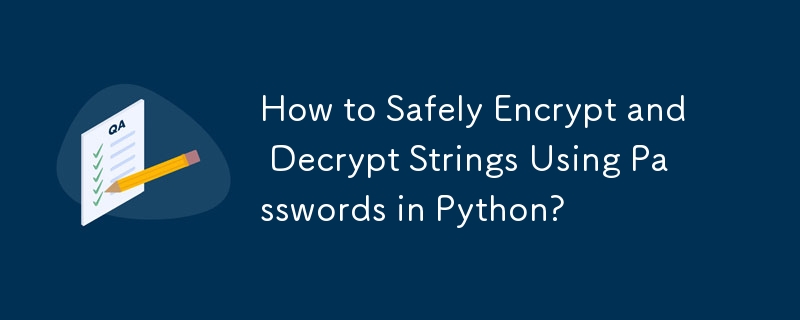
How to Safely Encrypt and Decrypt Strings Using Passwords in Python?
Article Introduction:Securely encrypting strings with passwords in Python involves using the Fernet class, which provides robust encryption and includes essential features such as a timestamp, HMAC signature, and base64 encoding. To enhance security, consider generating
2024-10-22
comment 0
434

How to encode a string to Base64 in Java?
Article Introduction:Import the java.util.Base64 class; 2. Use Base64.getEncoder().encodeToString() to convert the string to Base64 encoding. You must first convert the string into a byte array with UTF-8 encoding; 3. Optionally use Base64.getDecoder().decode() to decode the Base64 string to the original string, and then construct the original string with UTF-8; 4. For URL security scenarios, you can use Base64.getUrlEncoder(). This method is a standard, safe and efficient Base64 processing method in Java 8 and above, and the complete implementation includes encoding and decoding steps
2025-08-02
comment 0
613

What are some strategies for mitigating platform-specific issues in Java applications?
Article Introduction:How does Java alleviate platform-specific problems? Java implements platform-independent through JVM and standard libraries. 1) Use bytecode and JVM to abstract the operating system differences; 2) The standard library provides cross-platform APIs, such as Paths class processing file paths, and Charset class processing character encoding; 3) Use configuration files and multi-platform testing in actual projects for optimization and debugging.
2025-05-01
comment 0
944

How can you create a URL query string from a JavaScript object?
Article Introduction:Using URLSearchParams is the best way to create URL query strings from JavaScript objects. 1. The preferred URLSearchParams: Automatically generate correctly encoded query strings through newURLSearchParams(params).toString(), automatically process URL encoding, data type conversion, and ignore null or undefined values; 2. Parameters can be added step by step: use append() method to support duplicate key names, which are suitable for array class parameters; 3. When manually building, use Object.entries() combined with encodeURIComponent() to ensure safe encoding; 4.
2025-08-03
comment 0
211

Python Web Scraping with BeautifulSoup
Article Introduction:When learning BeautifulSoup, you need to pay attention to encoding processing, dynamic content, element positioning, headers settings and applicable scenarios. When using requests to get pages, you need to pay attention to coding issues, which can be solved through response.apparent_encoding or .content; you can use find() and find_all() methods to locate elements, and pay attention to the use of class keywords and multi-class processing; you need to handle dynamic loading content with interface crawling or Selenium and other tools; User-Agent should be set to avoid being blocked, and timeout and sleep control frequency should be added; BeautifulSoup is suitable for small and medium-sized models
2025-07-25
comment 0
196

php calculate remaining days
Article Introduction:Use the DateTime class to calculate the remaining days: get the DateInterval object by creating two DateTime objects and calling the diff() method, and then extract the days therein; 2. Use timestamp subtraction: convert the date to a timestamp and subtract it by using strtotime(), and use abs() to avoid negative values, and finally convert it to an integer number of days; 3. Consider the impact of time zone and daylight saving time: Specify the time zone of DateTime to ensure accuracy, especially when changing across daylight saving time, which may affect the number of hours. These three methods can meet the requirements for remaining days calculation in most PHPs.
2025-07-07
comment 0
305

C typeid example
Article Introduction:typeid is an operator used in C to obtain runtime type information and must contain a header file; 1. It can be used for type comparison of basic types. typeid(a).name() returns the compiler-related encoding name, and the types can be judged by comparison. 2. When used in polymorphic classes, only the class defines a virtual function to correctly obtain the dynamic type of the object pointed to by the pointer, otherwise only the static type will be returned; 3. In GCC/Clang, abi::__cxa_demangle can be used in GCC/Clang to convert the encoding name to a readable type name, but this method is a non-standard extension and is not applicable to all compilers; typeid is suitable for debugging and logging scenarios, and should not be used excessively in performance-sensitive code.
2025-08-04
comment 0
236

Building Machine Learning Models with Python Scikit-learn
Article Introduction:The steps to quickly build a machine learning model using Scikit-learn are as follows: 1. Data preparation, organize the data into a NumPy array or PandasDataFrame, and process missing values, feature scaling and category encoding; 2. Model selection and training, start from a simple model such as linear regression, import the model class and call the .fit() method to train; 3. Model evaluation, use accuracy, recall, f1-score (classification) or mean_squared_error, r2_score (regression) and combine cross-validation to check stability; 4. Parameter adjustment optimization, use GridSearchCV or Random
2025-07-13
comment 0
218

How to handle API authentication in Python
Article Introduction:The key to dealing with API authentication is to understand and use the authentication method correctly. 1. APIKey is the simplest authentication method, usually placed in the request header or URL parameters; 2. BasicAuth uses username and password for Base64 encoding transmission, which is suitable for internal systems; 3. OAuth2 needs to obtain the token first through client_id and client_secret, and then bring the BearerToken in the request header; 4. In order to deal with the token expiration, the token management class can be encapsulated and automatically refreshed the token; in short, selecting the appropriate method according to the document and safely storing the key information is the key.
2025-07-13
comment 0
1170
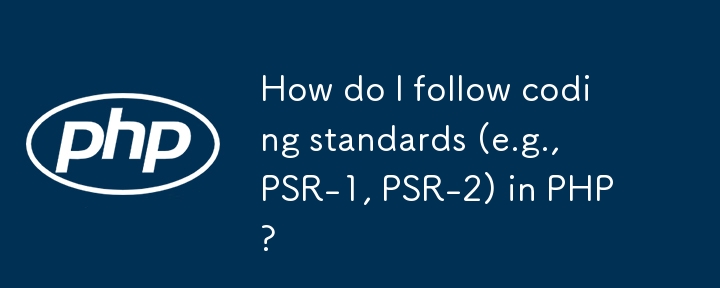
How do I follow coding standards (e.g., PSR-1, PSR-2) in PHP?
Article Introduction:Complying with PSR-1 and PSR-2 standards is crucial for PHP project development. 1. Use code formatting tools such as PHP-CS-Fixer and PHP_CodeSniffer to automatically handle code style issues and integrate them into IDE or CI processes; 2. Comply with the basic naming and structural rules in PSR-1, including the naming method of using the correct PHP tags, class names and method names; 3. Follow the code structure details in PSR-2, such as controlling spaces after structural keywords, left curly braces and 4 space indentation; 4. Unify the encoding style in the project, ensure consistency through .editorconfig files, and write specifications to README or contribution guide to support team collaboration. These practices
2025-06-26
comment 0
1018
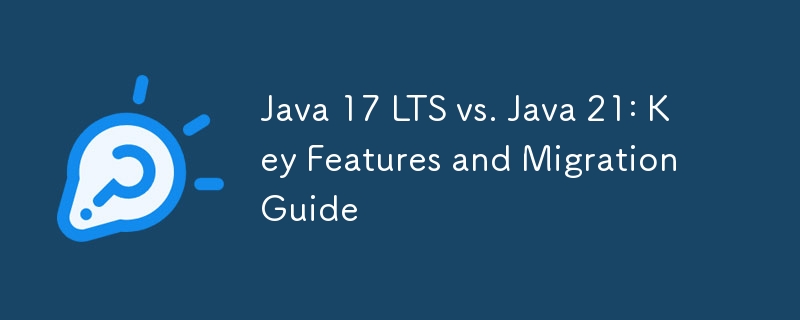
Java 17 LTS vs. Java 21: Key Features and Migration Guide
Article Introduction:Compared with Java17, Java21 has significantly improved concurrency, language features and performance. It is recommended to migrate as soon as possible. 1. Virtual threads (formal) greatly reduce resource overhead in high concurrency scenarios and simplify asynchronous programming; 2. Structured concurrency (preview) improves the readability and reliability of multi-threaded code; 3. Pattern matching and recording patterns enhance conditional judgment and data deconstruction capabilities; 4. ZGC supports concurrent class unloading to reduce pause time; 5. Default UTF-8 encoding solves cross-platform garbled code problems; 6. External functions and memory APIs provide safer local calling methods; dependency compatibility (such as SpringBoot3), adjust JVM parameters, update build configuration, enable preview features and conduct full testing, especially
2025-07-27
comment 0
882


